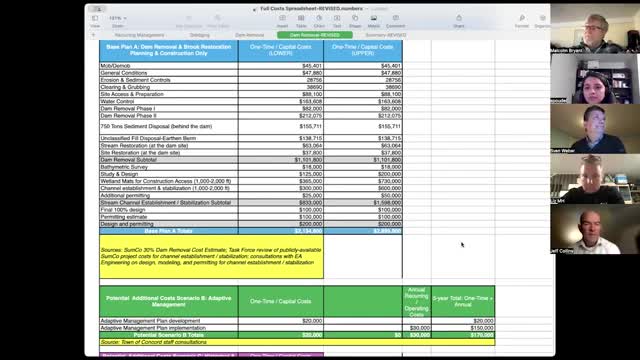Task force examines FEMA map implications and cautions on USGS StreamStats output
February 16, 2025 | Town of Concord, Middlesex County, Massachusetts
This article was created by AI summarizing key points discussed. AI makes mistakes, so for full details and context, please refer to the video of the full meeting. Please report any errors so we can fix them. Report an error »

Town of Concord task force members raised two technical questions: whether removing the impoundment will require a formal FEMA Letter of Map Revision (LOMR) and whether an online USGS product called StreamStats can reliably predict the post-removal channel path.
Why it matters: a required LOMR could add measurable cost and schedule implications; misunderstanding StreamStats output could mislead residents about likely channel location after removal.
FEMA mapping: Task force members said initial guidance from the Division of Ecological Restoration suggested a LOMR is typically not required for dam removals where the project is "run of river" and does not change the 100-year flood extent materially. Jeff reported that Gilead/VA (project contacts) will look further into the requirement and that a LOMR — if required — could cost on the order of $50,000 to complete because it requires hydrologic calculations and supporting documentation.
USGS StreamStats: The group reviewed a screen grab from USGS StreamStats that appeared to route the channel south of Scout Island. Jeff explained that StreamStats uses a digital-elevation-based "stream grid" and, for impounded (flat-water) areas, creates an artificial shortest path from inflow to outflow. He said that StreamStats is not intended to predict the natural, post-removal stream route inside an impoundment because the model does not incorporate bathymetry; instead it uses a shortest-path algorithm over a gridded elevation surface.
EA Engineering’s hydrology and previous alternatives analyses were cited as the more reliable sources for where the channel is likely to form; those reports indicate the post-removal flow path is unlikely to follow the StreamStats shortest-path output and, at least initially, will follow the channel path identified in the consultants’ reports.
Next steps: staff will seek written confirmation about the likelihood a LOMR is required and a cost estimate for that work. The task force will use EA Engineering’s bathymetry and hydrology findings — not StreamStats screen grabs alone — when preparing public-facing graphics.
Ending: Members agreed that StreamStats output should be treated cautiously and that any LOMR question needs a definitive, written answer from the appropriate technical or regulatory authority before the public presentation.
Why it matters: a required LOMR could add measurable cost and schedule implications; misunderstanding StreamStats output could mislead residents about likely channel location after removal.
FEMA mapping: Task force members said initial guidance from the Division of Ecological Restoration suggested a LOMR is typically not required for dam removals where the project is "run of river" and does not change the 100-year flood extent materially. Jeff reported that Gilead/VA (project contacts) will look further into the requirement and that a LOMR — if required — could cost on the order of $50,000 to complete because it requires hydrologic calculations and supporting documentation.
USGS StreamStats: The group reviewed a screen grab from USGS StreamStats that appeared to route the channel south of Scout Island. Jeff explained that StreamStats uses a digital-elevation-based "stream grid" and, for impounded (flat-water) areas, creates an artificial shortest path from inflow to outflow. He said that StreamStats is not intended to predict the natural, post-removal stream route inside an impoundment because the model does not incorporate bathymetry; instead it uses a shortest-path algorithm over a gridded elevation surface.
EA Engineering’s hydrology and previous alternatives analyses were cited as the more reliable sources for where the channel is likely to form; those reports indicate the post-removal flow path is unlikely to follow the StreamStats shortest-path output and, at least initially, will follow the channel path identified in the consultants’ reports.
Next steps: staff will seek written confirmation about the likelihood a LOMR is required and a cost estimate for that work. The task force will use EA Engineering’s bathymetry and hydrology findings — not StreamStats screen grabs alone — when preparing public-facing graphics.
Ending: Members agreed that StreamStats output should be treated cautiously and that any LOMR question needs a definitive, written answer from the appropriate technical or regulatory authority before the public presentation.
View full meeting
This article is based on a recent meeting—watch the full video and explore the complete transcript for deeper insights into the discussion.
View full meeting
